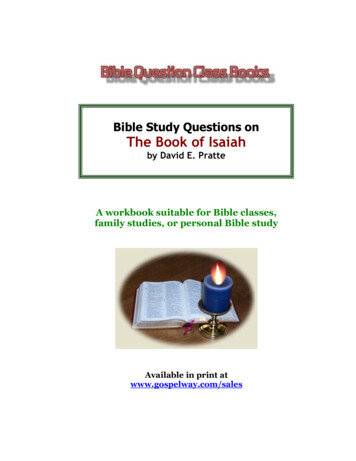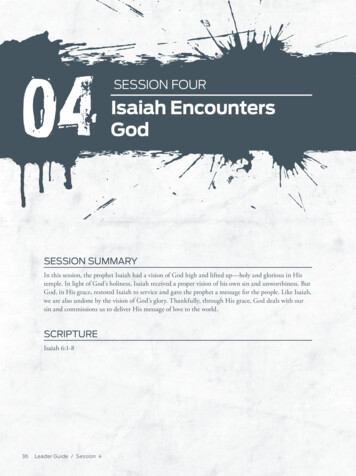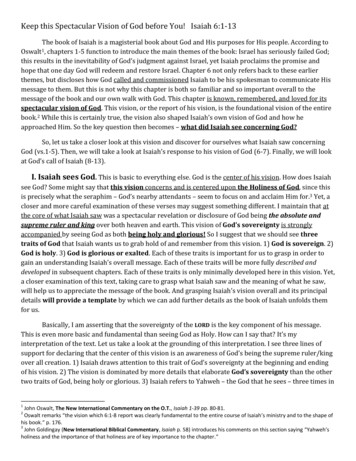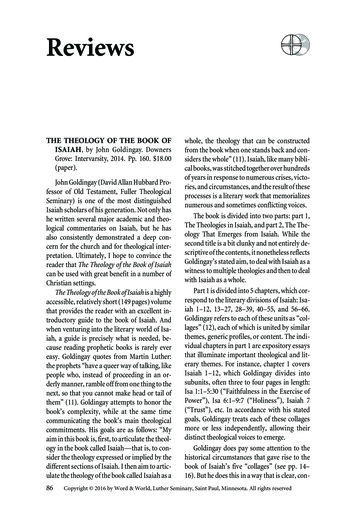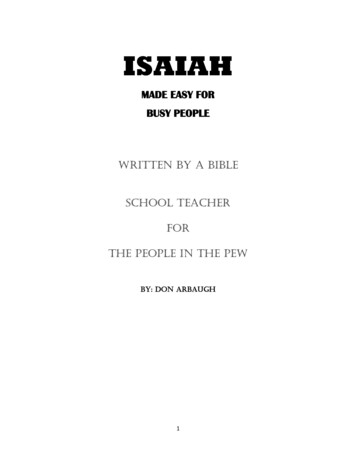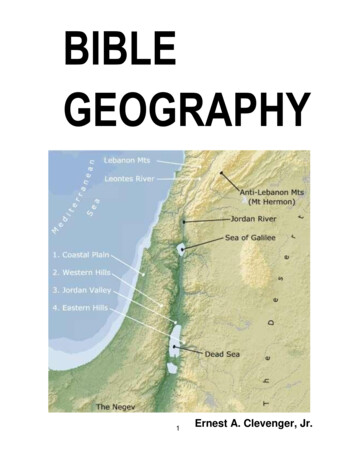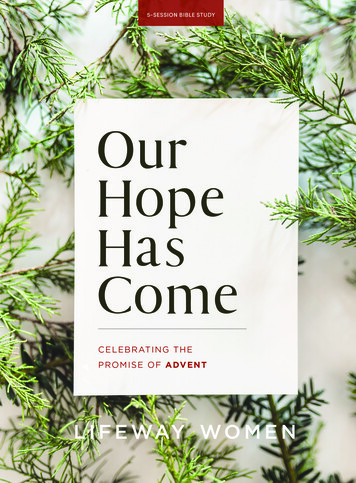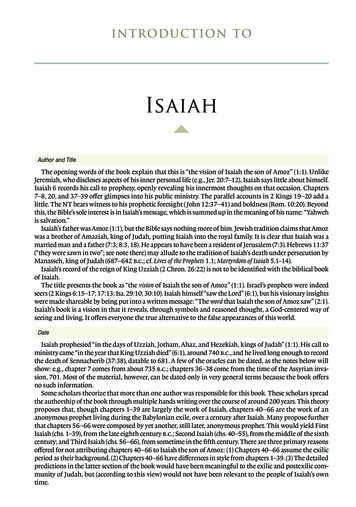
Transcription
Introduction ToIsaiahAuthor and TitleThe opening words of the book explain that this is “the vision of Isaiah the son of Amoz” (1:1). UnlikeJeremiah, who discloses aspects of his inner personal life (e.g., Jer. 20:7–12), Isaiah says little about himself.Isaiah 6 records his call to prophesy, openly revealing his innermost thoughts on that occasion. Chapters7–8, 20, and 37–39 offer glimpses into his public ministry. The parallel accounts in 2 Kings 19–20 add alittle. The NT bears witness to his prophetic foresight ( John 12:37–41) and boldness (Rom. 10:20). Beyondthis, the Bible’s sole interest is in Isaiah’s message, which is summed up in the meaning of his name: “Yahwehis salvation.”Isaiah’s father was Amoz (1:1), but the Bible says nothing more of him. Jewish tradition claims that Amozwas a brother of Amaziah, king of Judah, putting Isaiah into the royal family. It is clear that Isaiah was amarried man and a father (7:3; 8:3, 18). He appears to have been a resident of Jerusalem (7:3). Hebrews 11:37(“they were sawn in two”; see note there) may allude to the tradition of Isaiah’s death under persecution byManasseh, king of Judah (687–642 b.c.; cf. Lives of the Prophets 1.1; Martyrdom of Isaiah 5.1–14).Isaiah’s record of the reign of King Uzziah (2 Chron. 26:22) is not to be identified with the biblical bookof Isaiah.The title presents the book as “the vision of Isaiah the son of Amoz” (1:1). Israel’s prophets were indeedseers (2 Kings 6:15–17; 17:13; Isa. 29:10; 30:10). Isaiah himself “saw the Lord” (6:1), but his visionary insightswere made shareable by being put into a written message: “The word that Isaiah the son of Amoz saw” (2:1).Isaiah’s book is a vision in that it reveals, through symbols and reasoned thought, a God-centered way ofseeing and living. It offers everyone the true alternative to the false appearances of this world.DateIsaiah prophesied “in the days of Uzziah, Jotham, Ahaz, and Hezekiah, kings of Judah” (1:1). His call toministry came “in the year that King Uzziah died” (6:1), around 740 b.c., and he lived long enough to recordthe death of Sennacherib (37:38), datable to 681. A few of the oracles can be dated, as the notes below willshow: e.g., chapter 7 comes from about 735 b.c.; chapters 36–38 come from the time of the Assyrian invasion, 701. Most of the material, however, can be dated only in very general terms because the book offersno such information.Some scholars theorize that more than one author was responsible for this book. These scholars spreadthe authorship of the book through multiple hands writing over the course of around 200 years. This theoryproposes that, though chapters 1–39 are largely the work of Isaiah, chapters 40–66 are the work of ananonymous prophet living during the Babylonian exile, over a century after Isaiah. Many propose furtherthat chapters 56–66 were composed by yet another, still later, anonymous prophet. This would yield FirstIsaiah (chs. 1–39), from the late eighth century b.c.; Second Isaiah (chs. 40–55), from the middle of the sixthcentury; and Third Isaiah (chs. 56–66), from sometime in the fifth century. There are three primary reasonsoffered for not attributing chapters 40–66 to Isaiah the son of Amoz: (1) Chapters 40–66 assume the exilicperiod as their background. (2) Chapters 40–66 have differences in style from chapters 1–39. (3) The detailedpredictions in the latter section of the book would have been meaningful to the exilic and postexilic community of Judah, but (according to this view) would not have been relevant to the people of Isaiah’s owntime.
Introduction to Isaiah123 4These reasons for dividing the book suffer from severe shortcomings, and it is better to take the heading(1:1) as indicating that the entire book comes from Isaiah, the son of Amoz.1. There is unified testimony from the ancient world for single authorship. (1) The NT refers to passagesthroughout the book as the work of Isaiah (see Matt. 3:3; 4:14–16; 8:17; 12:17–21; 13:14–15; 15:7–9; Mark7:6–7; Luke 3:4–6; 4:17–19; John 1:23; 12:37–41; Acts 8:27–35; 28:25–27; Rom. 9:27–29; 10:16, 20–21;15:12). The NT acknowledges no other author or authors. The testimony of Jesus in John 12:41 is especiallyinstructive: “Isaiah said these things because he saw his glory and spoke of him.” “These things,” which isplural, refers to the two previous quotations in John 12:38 (using Isa. 53:1, from the so-called “SecondIsaiah”) and John 12:40 (using Isa. 6:10, from so-called “First Isaiah”), but Jesus refers to the one person,Isaiah, who both “saw his glory” and “spoke of him.” (2) The intertestamental book of Sirach (48:24–25) andthe first-century Jewish historian Josephus ( Jewish Antiquities 11.5–6) attest Isaiah’s authorship of the wholebook. (3) A Hebrew manuscript of Isaiah in the Dead Sea Scrolls bears witness to the seamless unity of thebook as the work of Isaiah. (4) It is hard to imagine how prophets could have issued such oracles as thoseof Isaiah 40–66, which were of such importance in the history of Judah, and yet fade into obscurity. (5) LaterOT authors seem to cite prophecies from chapters 40–66, which they could not have done if the book werebroken up as described (e.g., see note on 60:7, used in Ezra 7:27).2. There are many distinctive features of Isaiah’s style that run through all three parts. For example,Isaiah’s characteristic title for the Lord is “the Holy One of Israel,” which appears 25 times in the whole book(12 times in Isaiah 1–39; 11 times in chs. 40–55; and twice in chs. 56–66). It appears only six times outsideof Isaiah: twice in Jeremiah, three times in the Psalms, and in 2 Kings 19:22 (cf. Isa. 37:33). The phrase “highand lifted up” is a feature of Isaiah, appearing in 2:12–14; 6:1; 52:13; 57:15 (i.e., in each of the three sections;see note on 6:1). The notes will show other aspects of coherent thought and expression in Isaiah. Any differences of style can be explained by the different topics of the chapters and by different stages in Isaiah’slife (e.g., Isaiah may have written chapters 40–66 after the Assyrian invasion of 701 b.c.).3. The predictive material in chapters 40–66 is highly relevant both to the exilic audience and to Isaiah’sown day. Certainly it demonstrates the Lord’s rule over history; these chapters appeal to it for that purpose(e.g., 41:21–29), and Josephus ( Jewish Antiquities 11.5–7) records a story of the impression the specific prediction of Cyrus (Isa. 44:28) made on the Persian monarch when he learned of it (a prediction made about 150years in advance). The biblical worldview, which begins with the majestic Creator, can readily accept this.Further, chapters 40–66 often mention pagan religion, but specifically Babylonian material is rare (46:1);most address Canaanite idolatry, which Judah mixed in with their worship of Yahweh (e.g., 57:5; 66:3, 17;cf. 40:19; 41:7, 29; 42:17; 45:16–20; 46:6; 48:5; and the extended satire on idolatry, 44:9–20)—and this wasno longer a problem in Judah after the fall of Jerusalem.However, the primary significance of this predictive material resides in a wider context. The whole bookportrays God’s plan for Judah as a story that is headed somewhere, namely, toward the coming of the finalheir of David who will bring light to the Gentiles. Israel was created for this very purpose, and it will requirethat God’s people be purified of those members whose lives destroy that mission (see note on 1:24–28). Thisprospect of a glorious future enlists all believing readers to dedicate themselves to living faithfully and toembrace the dignity of playing a part in its development (cf. 2:5).At the heart of Isaiah’s message is God’s purpose of grace for sinners. If that ultimate miracle is accepted—and one cannot be a Christian without accepting it—then a lesser miracle is no barrier. Indeed, the prophetmaking predictions of future events is not a problem; it is, as Isaiah intended it to be, encouraging evidenceof God’s sovereign salvation intercepting a sinful world.ThemeThe central theme of the book is God himself, who does all things for his own sake (48:11). Isaiah defineseverything else by its relation to God, whether it is rightly adjusted to him as the gloriously central figurein all of reality (45:22–25). God is the Holy One of Israel (1:4), the One who is high and lifted up but whoalso dwells down among the “contrite and lowly” (57:15), the Sovereign over the whole world (13:1–27:13)whose wrath is fierce (9:12, 17, 21; 10:4) but whose cleansing touch atones for sin (6:7), whose salvationflows in endless supply (12:3), whose gospel is “good news of happiness” (52:7), who is moving historytoward the blessing of his people (43:3–7) and the exclusive worship due him (2:2–4). He is the only Savior(43:10–13), and the whole world will know it (49:26). To rest in the promises of this God is his people’s onlystrength (30:15); to delight themselves in his word is their refreshing feast (55:1–2); to serve his cause istheir worthy devotion (ch. 62); but to rebel against him is endless death (66:24).A microcosm of the book’s message appears in 1:2–2:5. The Lord announces his basic charge against the
1235Introduction to Isaiahpeople: they have received so much privilege from God and ought to be grateful children, but “theyhave despised the Holy One of Israel” (1:2–4). He describes the purpose of the various judgments they face,namely, to bring them to repentance, or at least to preserve a remnant who will repent (1:5–9). Judah is verydiligent to observe the divinely appointed sacrifices, but the people’s hearts are far from God, as their unwillingness to protect their own weakest members exhibits (1:10–20). The Lord called his people to be theembodiment of faithfulness in this world, and yet they are now filled with rampant unfaithfulness at everylevel (personal, religious, and social); but God intends to purge Zion of its sinful members and set her upas a beacon of light for the whole world. In view of this glorious future, Isaiah’s contemporaries shouldcommit themselves afresh to walking “in the light of the Lord” (1:21–2:5).Purpose, Occasion, and BackgroundIsaiah announces God’s surprising plan of grace and glory for his rebellious people and, indeed, for theworld. God had promised Abraham that through his descendants the world would be blessed (Gen. 12:1–3).God had promised David that his throne would lead the world into salvation (2 Sam. 7:12–16; Ps. 89:19–37).But by Isaiah’s time, the descendants of Abraham and many members of the dynasty of David no longertrusted the promises of God, aligning themselves instead with the promises—and the fears—of this falseworld. Judah’s unbelief in God during the pivotal events of Isaiah’s lifetime redirected their future awayfrom blessing and toward judgment. At this historic turning point, Judah moved from independence underGod’s power to subservience under pagan powers.What, then, of God’s ancient promises? Is the gracious purpose of God defeated by Judah’s sin? Isaiah answersthat question. After the prefatory chapters 1–5, his answer unfolds in chapters 6–27, and the rest of the bookdevelops the serious but hopeful message of these chapters. Isaiah’s answer is that, although God must purifyhis people through judgment, he has an overruling purpose of grace, beginning with Isaiah himself (ch. 6),spreading to Judah (7:1–9:7) and Israel (9:8–11:16), and resulting in endless joy (12:1–6). Even the nations ofthe world are taken into account (13:1–27:13). The purpose of Isaiah, then, is to declare the good news thatGod will glorify himself through the renewed and increased glory of his people, which will attract the nations.The book of Isaiah is a vision of hope for sinners through the coming Messiah, promising for the “ransomed”people of God a new world where sin and sorrow will be forever forgotten (35:10; 51:11).Isaiah’s book envisions three historical settings (see chart): (1) chapters 1–39 are set against the backgroundof Isaiah’s own times in the late eighth century b.c.; (2) chapters 40–55 assume the Jewish exiles in Babylonin the sixth century as their audience; and (3) chapters 56–66 take the returned exiles and subsequentgenerations of God’s people as their backdrop. It would be a mistake, however, to suppose that the chaptershave relevance only to their assumed audiences: the long-range prophecies of chapters 40–66, as alreadyindicated, challenge all the people of Judah in Isaiah’s time to accept their role in a story that is headed toa glorious future and to live faithfully in that light (cf. 2:5, on the heels of 2:1–4). Further, the entire book,as canonical Scripture, addresses all the people of God until Christ returns.First, in his own times, Isaiah prophesied “in the days of Uzziah, Jotham, Ahaz, and Hezekiah, kingsof Judah” (1:1). Called by God “in the year that King Uzziah died” (6:1), his long ministry began in 740 b.c.The external threat of Isaiah’s day was the militant Assyrian Empire rising to power in the east. The question forced upon Judah by this threat was one of trust: in what will God’s people trust for salvation—inhuman strategies of self-rescue, or in prophetic promises of divine grace?This question of what and whom to trust intensified on two occasions. The first occurred c. 735 b.c., during the reign of King Ahaz. Under pressure from Assyria, the northern kingdom of Israel formed a pact ofISAIAH CHART 4Simplified Overview of IsaiahIsaiah 1–39Isaiah 40–55Isaiah 56–66Date andSettingThe eighth century B.C. (700s); the AssyrianthreatProphecies about the sixth century B.C.(500s); the Babylonian exileProphecies about all times and occasionsuntil the endAudienceGod’s rebellious people craving worldlysecurityGod’s defeated people under worldlydominationAll who hold fast to God’s covenantActionsGod purifies a remnant of his apostatepeople through judgmentGod consoles his discouraged people inexileGod prepares all of his true people for hispromised salvationMessage“In returning and rest you shall be saved;. . . But you were unwilling” (30:15)“the glory of the LORD shall be revealed”(40:5)“Keep justice, and do righteousness”(56:1)
Introduction to Isaiah1236***ISAIAH MAP [L] 1. (ISAIAH 0:00)*** Gordion TarsusArpadCarchemish Nineveh AsshurEcbatana The Near East at the Time of Isaiahc. 740 B.C.The prophecies of Isaiah are set against thebackdrop of a rising Assyrian Empire. This resurgentancient nation posed a great threat to Israel andJudah, and it would eventually engulf nearly theentire Near East from Ur to Ararat to Egypt.Hamath Tyre Damascus Samaria Jerusalem 0 UrDumah0 Susa Memphis Babylon200200400 400 mi600 kmmutual defense with Syria, and together these two kingdoms aimed to force Judah into alignment withthem (ch. 7). But God could be trusted to stand by his commitment to defend the Davidic throne. Accordingly,map.23-1.indd 66/25/08 5:49:19 PMIsaiah assured Ahaz of God’s saving purpose. But Ahaz refused God, preferring the power of Assyria, andnegotiated for pagan protection (2 Kings 16:5–9). Thus Ahaz surrendered the sovereignty of the Davidicthrone to a nation hostile to the kingdom of God, and achieved nothing in return. The coalition arrayedagainst Judah failed—Syria fell in 732 b.c. and Israel in 722, as God had said they would (Isa. 7:16; 8:4).00600 Miles The second crisis occurred in 701 b.c., during the reign of Hezekiah. This time Assyria was the threat. Asbefore, the temptation was to negotiate an alliance of defense with human powers, in this case with Egypt(30:1–7; 31:1–3; 36:6). Judah chose the false refuge of human promises rather than to rest on the Lord’s00 900 Km“sure foundation” (28:14–22). Assyria then set out to punish Judah for its pact with Egypt. Hezekiah tried00600 Milesto buy peace from the Assyrians (2 Kings 18:13–16), but they turned on him (Isa. 33:1). Under extremepressure, Hezekiah finally put his trust in the Lord and found him to be powerfully faithful (chs. 36–37).The eventual downfall of Judah was foreseen in Hezekiah’s unguarded openness to Babylonian influence00 900 Km(ch. 39). Isaiah discerned in Hezekiah’s enthusiasm for Babylon a future of captivity there for God’s people.Second, Isaiah was enabled by God to address the Jewish captives far away in Babylon in the sixth centuryb.c. He announces a promise that God is coming with a world-changing display of his glory (40:5). Toprepare for his coming, the exiles must return to the Promised Land (48:20). They must not be demoralizedby the impressive but empty culture of idolatry in which they live (41:21–24), nor should they resent God’suse of a pagan conqueror, Cyrus the Great, as their liberator from Babylon (44:24–28). They must look byfaith for a greater liberator still to come, the messianic “servant of the Lord” (see note on 42:1–9). He willbring justice to the nations (42:1–4) and save his people from their ultimate captivity, the guilt of sin(52:13–53:12). Since the faith of God’s people had already proven weak, God pledges that he alone willaccomplish this, for his own glory (48:9–11).Third, Isaiah addressed the returned exiles and subsequent generations of God’s people with messagesof challenge and hope, to keep their faith and obedience steady until God fulfills all his promises. Isaiahmakes clear the spiritual and universal nature of God’s true people (56:3–8; 66:18–23). He sees the finaltriumph of One who is “mighty to save” (63:1). His prophetic eye looks beyond the fraudulence of thisworld, all the way forward to the eternal finality of God’s renewed people in a renewed cosmos (65:17;66:22). “Therefore let us be grateful for receiving a kingdom that cannot be shaken” (Heb. 12:28).Key ThemesWith God himself as the center of Isaiah’s vision, multiple supportive themes are entailed:1. God is offended by religious ritual, however impressive, if it conceals an empty heart and a carelesslife (1:10–17; 58:1–12; 66:1–4).2. God’s true people will become a multinational community of worship and peace forever (2:2–4; 19:19–25;
1237Introduction to Isaiah25:6–9; 56:3–8; 66:18–23), and the predominant culture of a new world (14:1–2; 41:8–16; 43:3–7; 45:14–17;49:19–26; 60:1–22).3. God opposes all manifestations of human pride (2:10–17; 10:33–34; 13:11; 16:6; 23:9; 28:1–4).4. The foolish idols that man creates are destined for destruction (2:20–21; 19:1; 31:6–7; 44:9–20;46:1–7).5. Though God’s judgment will reduce his people to a remnant, his final purpose is the joyful triumphof his grace (1:9; 6:1–12:6; 35:1–10; 40:1–2; 49:13–16; 51:3; 54:7–8; 55:12–13).6. God is able to judge people by rendering them deaf and blind to his saving word (6:9–10; 28:11–13;29:9–14; 42:18–25).7. The only hope of the world is bound up in one man—the promised Davidic king (4:2; 7:14; 9:2–7;11:1–10), the servant of the Lord (42:1–9; 49:1–13; 50:4–9; 52:13–53:12), the anointed preacher of the gospel(61:1–3), and the lone victor over all evil (63:1–6).8. God is actively using creation and history, and even the wrongs of man, for his own glory (10:5–19;13:1–27:13; 36:1–39:8; 40:12–26; 44:24–45:13).9. With a great and holy God ruling all things, man’s duty is a repentant trust in him alone (7:9; 10:20;12:2; 26:3–4; 28:12, 16; 30:15–18; 31:1; 32:17–18; 36:1–37:38; 40:31; 42:17; 50:10; 55:1–7; 57:13, 15; 66:2).10. God’s people, feeling abandoned by God (40:27; 49:14; 51:12–13), foolishly put their trust in worldlypowers (7:1–8:22; 28:14–22; 30:1–17; 31:1–3; 39:1–8).11. God will uphold his own cause with a world-transforming display of his glory (4:2–6; 11:10; 35:1–2;40:3–5; 52:10; 59:19; 60:1–3; 66:18).12. God uses predictive prophecy to prove that his hand is guiding human history (41:1–4, 21–29; 44:6–8;44:24–45:13; 46:8–11; 48:3–11).13. God’s past faithfulness and the certainty of his final victory motivate his people toward prayer andpractical obedience now (56:1–2; 62:1–64:12).14. The wrath of God is to be feared above all else (5:25; 9:12, 17, 19, 21; 10:4–6; 13:9, 13; 30:27; 34:2;59:18; 63:1–6; 66:15–16, 24).History of Salvation SummaryIsaiah shares with the rest of the OT a high view of the mission of Israel. God called Abraham and hisfamily to be the vehicle by which he would bring to the whole world the blessing of knowing the true God(Gen. 12:1–3). The great tragedy of Israel was their repeated faithlessness, which hid the light from theGentiles. God will not be thwarted, however, and in order to bless the Gentiles he will purify his people(Isa. 1:24–28) and from them raise up the heir of David.Though Isaiah denounces hypocrisy, greed, and idolatry as offenses against God, he also foresees theSavior of offenders, the Lord Jesus Christ, who is God-with-us (7:14), the child destined to rule forever(9:6–7), the hope of the Davidic throne (11:1), the glory of the Lord (40:5), the suffering servant of the Lord(42:1–9; 49:1–6; 50:4–9; 52:13–53:12), the anointed preacher of the gospel (61:1–3), the bloodied victorover all evil (63:1–6), and more. Isaiah is mentioned by name in the NT over 20 times and is quoted thereextensively, for the message he preached is the very gospel of Jesus and the apostles.Isaiah’s message makes an impact on every reader in one of two ways. Either this book will harden thereader’s pride against God (6:9–10; 28:13; 29:11–12) or it will become to the contrite reader a feast of refreshment in God (55:1–3; 57:15; 66:2). Through Isaiah’s vision the eyes of faith see their iniquity laid on Another(53:6), they see a new Jerusalem of eternal gladness (65:17–18), they see all humanity giving God the worship that is his due forever (66:22–23), and that prophetic vision keeps their hope alive. As with the rest ofthe OT, these things were written “that through endurance and through the encouragement of the Scriptureswe might have hope” (Rom. 15:4). (For an explanation of the “History of Salvation,” see the Overview of theBible, pp. 23–26. See also History of Salvation in the Old Testament: Preparing the Way for Christ,pp. 2635–2662.)Literary FeaturesThe overall genre of the book is prophecy. Although biblical prophets primarily tell forth God’s messagein their contemporary situation, and less frequently foretell the future, the last third of Isaiah is an exceptionin being mainly predictive of the future. It is important to clarify two literary features of the foretelling:first, having been received in visions, it has many figurative elements; and second, its purpose is not simply
Introduction to Isaiah123 8to tell the future but to express the author’s sense of Israel’s place in God’s overarching redemptive plan forthe world.A book this large, and lacking a narrative line, must be viewed as an anthology or collection of individualcompositions. It is often futile to look for a smooth flow from one unit to the next. The book swings backand forth between oracles of judgment and oracles of salvation. The general movement of the book is froman emphasis on evil and judgment to rapturous visions of a coming redemption, a movement from bad newsto good news. But this is only a general pattern that should not lead readers to distort the smaller swings,between evil/judgment and redemption/restoration, which persist to the very last verses of the book.The opening movement of the book is more of a warning against sin than a blueprint for the future. AsIsaiah looks at his world, he depicts its evil, denounces that evil, and predicts God’s imminent judgment againstthat evil. All three of these ingredients are typically couched in the form of the oracle of judgment, a divineindictment of present evil. Additionally, biblical prophets intermingle and end their books with visions ofGod’s restored favor to his people; these visions are expressed in the form of the oracle of redemption (alsocalled the oracle of salvation) and oracle of blessing.The oracles of judgment need to be approached as examples of satire: they have an object of attack, avehicle in which the attack is embodied, a stated or implied norm by which the criticism is conducted, anda prevailing tone of either ridicule or disgust. Because much of the book of Isaiah envisions things thateither have not yet happened or do not literally happen (given the symbolic form in which they are portrayed), the genre of visionary writing is continuously operative in the book of Isaiah (the author envisionssomething that does not literally exist and/or that has not yet happened). A preponderance of the book iscast into the form of poetry, with the result that readers need to apply all that they know about staples ofpoetry, such as imagery, metaphor, simile, apostrophe, and hyperbole.Many of the visions of redemption in the last third of Isaiah are lyric in form and effect. Apocalypticwriting appears prominently in chapters 24–27. Because the agents who interact with God are often nationsrather than individuals, and because the forces of nature are also sometimes actors, the label “cosmic drama”is a helpful concept. Finally, in this book that encompasses such a diversity of material, there is even a fullfledged hero story involving King Hezekiah and the prophet Isaiah (chs. 36–39).OutlineI. Introduction: “Ah, Sinful Nation!” (1:1–5:30)A. Judah’s sins confronted (1:1–31)B. Judah’s hope, guilt, hope (2:1–4:6)1. Hope (2:1–5)2. Guilt (2:6–4:1)3. Hope (4:2–6)C. Judah’s sins condemned (5:1–30)II. God Redefines the Future of His People: “Your Guilt Is Taken Away” (6:1–12:6)A.B.C.D.Grace—through judgment—for Isaiah (6:1–13)Grace—through judgment—for Judah (7:1–9:7)Grace—through judgment—for Israel (9:8–11:16)The enjoyment of God’s grace (12:1–6)III. God’s Judgment and Grace for the World: “We Have a Strong City” (13:1–27:13)A. First series of oracles: the here and now (13:1–20:6)1. Babylon (13:1–14:27)2. Philistia (14:28–32)3. Moab (15:1–16:14)4. The Syria-Israel alliance (17:1–18:7)5. Egypt (19:1–20:6)B. Second series of oracles: the deeper truth (21:1–23:18)1. Babylon (21:1–10)2. Edom (21:11–12)3. Arabia (21:13–17)
1239Introduction to Isaiah4. Jerusalem (22:1–25)5. Tyre (23:1–18)C. Third series of oracles: the final end (24:1–27:13)1. The wasted city (24:1–20)2. The Lord will punish (24:21–23)3. He will swallow up death forever (25:1–12)4. He will ordain peace (26:1–21)5. The whole world will be fruitful (27:1–13)IV. God’s Sovereign Word Spoken into the World: “Ah!” (28:1–35:10)A. Six laments, with assurances (28:1–33:24)1. The proud crown of Ephraim (28:1–29)2. The city where David encamped (29:1–14)3. Those who turn things upside down (29:15–24)4. Stubborn children with their own plans (30:1–33)5. Those who go down to Egypt for help (31:1–32:20)6. The destroyer who has not been destroyed (33:1–24)B. Two final outcomes: judgment or salvation (34:1–35:10)V. Historical Transition: “In Whom Do You Now Trust?” (36:1–39:8)A. Practical trust in God vindicated (36:1–37:38)B. Human inconstancy sent into exile (38:1–39:8)VI. Comfort for God’s Exiles: “The Glory of the Lord Shall Be Revealed” (40:1–55:13)A.B.C.D.E.F.G.H.I.J.K.L.M.The God of glory: his coming, exclusivity, power (40:1–31)The one true God moving history for his people (41:1–20)False hopes, the Lord’s servant, a new song (41:21–42:17)God reclaims his people for his glory (42:18–43:21)God revives his people for his glory (43:22–44:23)God predicts his use of Cyrus (44:24–45:25)The gods and pride of Babylon doomed (46:1–47:15)God will free his people from Babylon for his own sake (48:1–22)The Lord’s servant displayed, his people assured (49:1–50:3)The Lord’s servant taught, his people attentive (50:4–51:8)Encouragements to a responsive faith (51:9–52:12)The Lord’s servant: the exalted sin-bearer (52:13–53:12)Compassion for God’s people, offered to all (54:1–55:13)VII. How to Prepare for the Coming Glory: “Hold Fast My Covenant” (56:1–66:24)A.B.C.D.E.F.G.H.I.J.The true people of God redefined (56:1–8)The false people of God exposed (56:9–57:13)The true people of God invited (57:14–21)The path to blessing: ritual vs. responsibility (58:1–59:13)Present failure, eternal covenant, future glory (59:14–60:22)The anointed Preacher renewing the world (61:1–62:12)The coming Victor; his past faithfulness (63:1–14)Praying for the power of God (63:15–64:12)The eagerness of God for his people’s eternal joy (65:1–25)True worship now and forever (66:1–24)
Isaiah1The a vision of Isaiah the son of Amoz, which he saw concerning Judah and Jerusalemin the days of c Uzziah, d Jotham, eAhaz, and f Hezekiah, kings of Judah.bThe Wickedness of JudahHear, O heavens, and give ear, O h earth;for the Lord has spoken:“Children1 i have I reared and brought up,but they have rebelled against me.3 The ox j knows its owner,and the donkey its master’s crib,but Israel does j not know,my people do not understand.”2gChapter 11a ch. 6:1 b Hos. 1:1; Mic.1:1 c [2 Kgs. 15:1, 7]; See2 Chr. 26 d See 2 Kgs.15:32-38; 2 Chr. 27 e ch.7:1, 3, 10, 12; 14:28; See2 Kgs. 16; 2 Chr. 28 f Seech. 37:2–39:8; 2 Kgs.18-20; 2 Chr. 29–322g Deut. 32:1; [Deut. 4:26]hMic. 1:2; 6:2 i [Deut.32:6, 10, 15]j3 [Jer. 8:7]4k [Matt. 3:7] l ch. 5:24mSee ch. 31:1 n Ezek. 14:55o Jer. 5:3; [ch. 9:13] p ch.31:64 Ah, sinful nation,a people laden with iniquity,k offspring of evildoers,children who deal corruptly!They have forsaken the Lord,they have l despised m the Holy One of Israel,they are utterly n estranged.Why will you still be o struck down?Why will you p continue to rebel?The whole head is sick,and the whole heart faint.51 Or Sons; also verse 41:1–5:30 Introduction: “Ah, Sinful Nation!” The prophet rebukes thepeople of God in order for them to place themselves under the judgmentof God’s word. Isaiah includes promises of miraculous grace beyond theremedial judgments. On 1:2–2:5 as a microcosm of the book’s message,see Introduction: Theme.1:1–31 Judah’s Sins Confronted. Isaia
Isaiah’s characteristic title for the Lord is “the Holy One of Israel,” which appears 25 times in the whole book (12 times in Isaiah 1–39; 11 times in chs. 40–55; and twice in chs. 56–66). It appears only six times outside of Isaiah: twice in Jeremiah, three times in the Psalms

